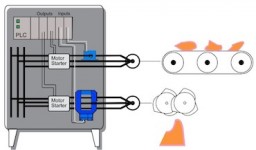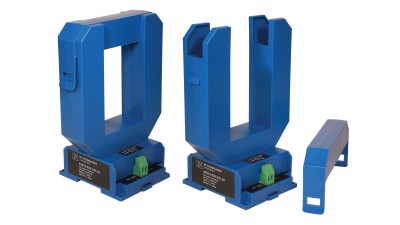The need to measure current draw of large machines is just as important as for smaller loads, however installing a

Use a large split-core AC current transducer to measure the load of a grinding, material reduction process. If the grinding wheels become overloaded, current use will spike and the sensor output will be captured by a programmable logic controller.
monitoring device is more difficult. Large wires do not bend easily and tend to spring back to their original shape when force is applied. Often heavy loads may use bus bars rather than cable, usually in control cabinets, switch boards and other distribution centers.
Using a solid-core current sensing device in any of these applications means threading the conductors through a ring and then onto the load terminals, a nearly impossible task when the conductors are solid bars. A split-core sensor allows the wires to be installed first and the sensor added after the installation. If the load is fed with a bus bar, the sensor can be slipped over the bar easily.
Often heavier amounts of current are carried using multiple wires for each phase. The primary requirement is having enough room to allow the sensing ring to completely surround the conductors. Bundling the wires together with nylon ties helps the conductors stay in one location while the sensor is installed. Good practice would allow the ties to stay in place so the conductors don’t spring outward and apply excessive force against the sides of the sensing ring.
Why go to the bother and expense of monitoring current?
While many specifying engineers require power monitoring, measuring voltage and current at the same instant to allow for power factor measurement, a very good representation of the power used can be achieved by measuring current only.
Using an RMS responding sensor will be much more accurate if the current wave shape is not purely sinusoidal, such as what would be produced by a variable frequency inverter or a phase angle fired heating controller. With this added signal conditioning, the sensor output has very little ripple and remains highly accurate regardless of whether the current is smooth and even or chopped significantly.
The majority of large pumps, compressor motors and fan loads are driven with variable frequency inverters to save power by running the drive motor only at the optimal speed for the work being done, along with reducing mechanical stress during startup. Using an RMS measurement rather than an average responding sensor can help reduce troubleshooting during the initial commissioning of a control system by showing an accurate signal in all situations.
The New AT/ATR-LS Current Transducer Makes Installation Easy on Large Machines
The AT/ATR-LS Series Current Transducers combine a current transformer and signal conditioner into a single package. The large, easy-to-install split-core design allows for installation over existing conductors without the need to disconnect the load, even in applications where there are multiple conductors per phase. For new installations, the installation is just as easy. Just remove the top portion of the sensing ring, place the conductors inside, and snap the top back in place. The transducer uses two wires to connect to the power supply and the load, programmable logic controller, panel meter or data acquisition system.

